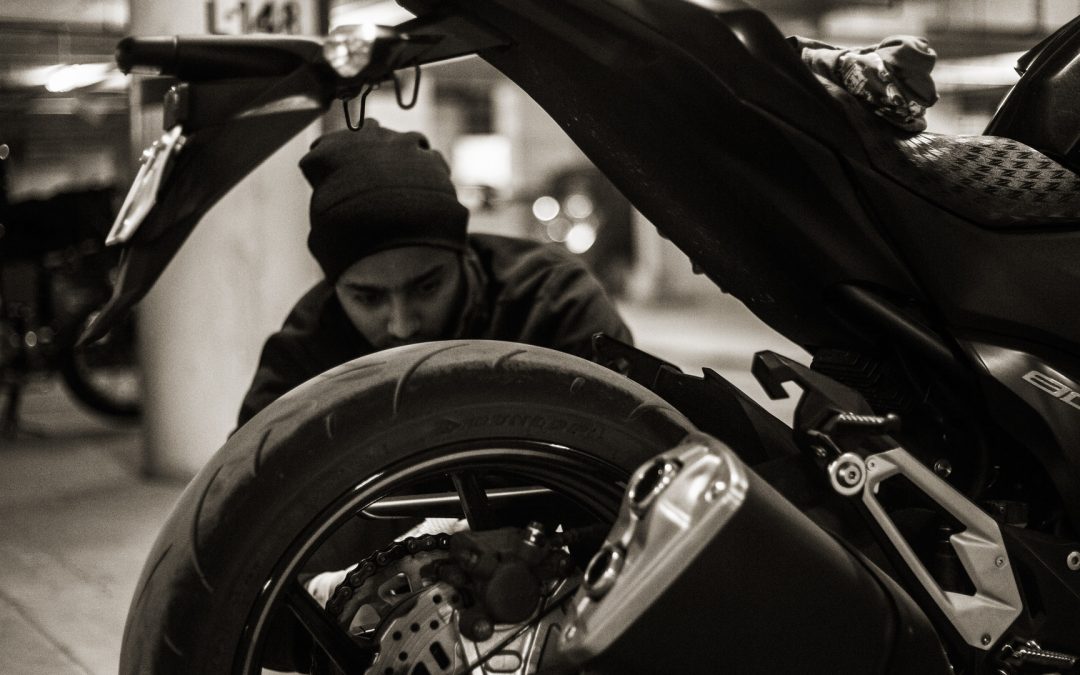Increase the chances of making every ride a safe ride by incorporating the Motorcycle Safety Foundation’s (MSF) T-CLOCS inspection into every ride. This simple check of a few key components can easily be completed in less than 5 minutes. By doing this every ride, you help ensure the safe operation of your motorcycle plus you can spot minor issues before they become major problems. The T-CLOCS inspection process is attributed to the M.S.F. or Motorcycle Safety Foundation and it stands for Tires, Controls, Lights, Oil, Chassis, and Stands. In addition, most owner’s manuals include a brand / model-specific version of a T-CLOCS inspection. I would highly suggest reading there first to pick up brand/model specific tips.
T – stands for TIRES
Check and make sure that front and rear tires are both inflated to the proper pressures for the situation i.e. carrying a passenger and/or luggage. While checking air pressure, you also want to measure the tread thickness. Examine the tread surface for any cuts, embedded debris, and other defects. Also, check the sidewalls for unusual cracks or bulges in the rubber. From here you can progress to the rims themselves.For rims that are cast, inspect closely for any cracks or dents. If you have spoked rims, randomly test several of them to check for proper tension. If correctly adjusted, no spokes should be able to move by hand. Grab the whole wheel and try to move it from side to side. Any movement here can indicate a failure in your wheel bearings. Check your front and rear brakes to make sure that everything seems normal and operational. To be able to check pressure and thickness with one tool, I would highly recommend Accutire’s MS-48B Digital Combination Tire Thread Depth Gauge and Tire Pressure Gauge.
C – stands for CONTROLS
The next step is checking your hand and foot controls. You want to make sure that any levers and pedals are undamaged, properly adjusted, and aren’t binding on anything. Check your throttle and clutch cables for smooth operation with no binding. Ensure that there is no wire fraying at any points along the cable. Check brake, ABS, clutch, and any of hydraulic hoses for bulges, leaks, or signs of breaking down and/or deterioration. Open and close your throttle to ensure crisp movement, with no binding, and that it immediately snaps back to a neutral position when released.
L – stands for LIGHTS
Make sure all your lights and electrical components are working. Check your headlamps (both low and high beams), tail and brake lights, as well as your front and rear turn signals. Don’t forget to make sure that your battery is fully charged. My battery (YTX12-BS Sealed iGel Motorcycle Battery) has a battery gauge on top which makes checking the power an easy process.
O – stands for OIL
Your bike’s fluids such as oil and other fluids are usually very easy to check with a quick visual inspection in most cases.. Hydraulic reservoirs for your clutch and/or brakes come with a sight glass opening or they’re made of translucent plastic, which makes the check for fluid levels an easy thing to do. For bikes that are liquid cooled versus air cooled, the overflow tank is made of translucent plastic, so you should be able to easily verify the correct levels with a glance.ant. Glass portholes are also common on the side of oil reservoirs so checking your oil level should be just as simple as the other fluids.
C – stands for CHASSIS
Now take a few moments to inspect the chassis. Rotate the handlebar(s) through their movement fully. They should move freely, with no sticking, and no feel of flat spots in the steering head bearings. With the bike on its center stand or work stand, grasp the fork legs near the axle and try to move them front-to-back. Any play indicates a problem. At the rear, grab the wheel and try to move it side-to-side. Again, any movement indicates a problem, in this case with the swingarm bearings. Check chain tension, lubrication, and alignment, then inspect the rear sprocket teeth for unusual wear. Take the bike off its stand, sit in the saddle and make sure both front and rear suspensions move freely and smoothly.
S- stands for STANDS
Inspect your side stand and/or center stand (if applicable). It should snap crisply back into place with no binding issues. Make sure you check for any cracks or bends that would signal an immediate need for repair. Also check that the stand springs are in good condition and that the unit, as a whole, will safely and securely support your motorcycle.
Read more at the Motorcycle Safety Foundation’s website.

